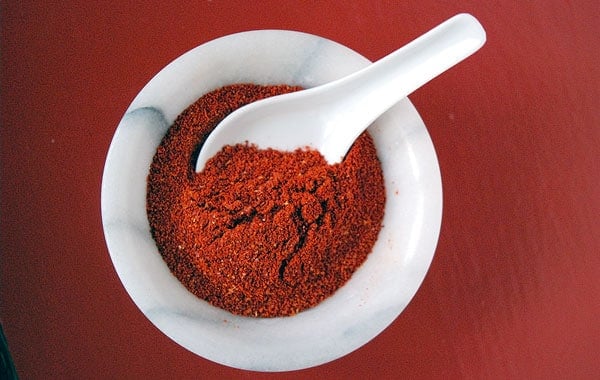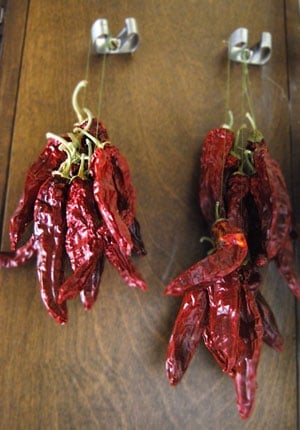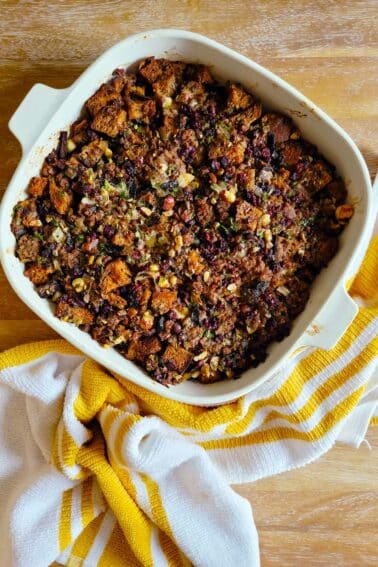As an Amazon Associate I earn from qualifying purchases.

Why bother making homemade paprika? Fair question. After all, the Spanish and Hungarians are better at it than we ever will be, right?
Why not just call up Penzey’s or somesuch and order some? Well, I do. But making something like paprika at home is not so much something I did out of necessity as it was an exercise in whether I could do it at all.
It’s not that I think the world is about to collapse and oh-where-oh-where will I get the paprika to make my chorizo or chili or goulash, not to mention deviled eggs? It’s that I have a fascination with how things are made; I am a sucker for those shows on Discovery Channel or NatGeo.
So I asked myself: “What would it take to make enough paprika for our household use for one year?” And just how do you make paprika?
Turns out making paprika is easy, but it takes a while. You basically need to start paprika long before you want the powder by growing the right kind of peppers. Almas or boldog peppers are standard: They’re vivid red peppers that aren’t too thick; bell peppers are not ideal. Why? Thick-walled peppers tend to rot when left to dry, although you can certainly use a dehydrator to prevent rot if all you have are ye olde bell peppers.
The reason paprika peppers are so special is because they have character. They are neither too sweet or too spicy. No matter what pepper you use, you want something in between. I find that poblanos, left to fully ripen, are another excellent substitute, but very different.
Here is a primer on all things paprika, if you want to go down that rabbit hole.
For my paprika experiment, I planted three Alma Paprika Pepper plants, and at the end of the season I had several strings of peppers hanging in our garage.

This first thing about making paprika I learned as I broke them into smaller bits to grind was this: Chiles need to be dried in arid, hot shade. Drying in the sun bleaches away color. Excess heat, like you’d get in an oven, adds an almost cooked aroma to the chiles.
And in all cases, humidity is the enemy. I dried a couple peppers in the (more humid, cooler) house and when I opened them up they were all fuzzy inside. Mold. I tossed them. None of the peppers in the garage had mold. (I live in Sacramento, California, where it is very hot and dry in the summer.)
Making the powder is pretty easy. Break the peppers into pieces small enough to jam into a spice grinder. I discard the seeds, because including seeds dilutes color and can increase the heat if you’re using hotter chiles. The grinding takes a few steps, because you always get a a few pieces that don’t want to grind. Keep sifting the bits through a fine-mesh sieve until you get an even powder.
That’s all there is to it.
In that first experiment, I wound up with 10 tablespoons of paprika from the peppers you see hanging in the picture. Definitely not enough for a year, but maybe for a few months — unless I wanted to make a huge batch of chorizo or Italian hot sausage. Given all this, I reckon I’d need 10 to 15 plants to supply me for a year.
The cool thing about this experiment is that 10 to 15 plants is actually a reasonable number in my garden, if I so chose to devote that much space to paprika. And since I am decent enough at growing chiles from seed, I could have a perpetual supply for nothing.
What’s more, my homemade paprika tastes just as good or better than the expensive kind I buy from Penzey’s. That was something of a surprise — and confirmation that there is no great mystery to making this spice. (Spanish smoked paprika is quite another thing.)
But still. Was it all worth it? The planting and the hanging and the months’ worth of waiting? Sure, if you have space and time. Grinding your own paprika is satisfying, and you get some really, really good spice out of it.




Fantastic ! I grew 9 alma pepper plants this year in my Portland Or. garden. Upon harvest I smoked the peppers for six hours. whole, but cleaned out
Then 2 days in the dehydrater and finally ground in blender and worked thru a fine strainer. What a great bid of fun and I have 2 cups of smoked paprika. cheers
Well, as you can see, I live in Hungary – LOTS of paprika. But like you wanted to have a bash at making my own so this year I have saved a load of peppers (the Hungarian paprika type) and they are ripening off and reddening up quite nicely. I did a search for “how to make paprika” and this site came out at No. 1.
I just love the bit about experimenting at doing things. Much of the same mindset myself.
Thanks for the info!
Here is one for you all. Take the chili’s, 2 lbs. fresh ones. Cut stems off. Cut into 1 inch pieces. Place in pot. Add 1-2 cups water. Bring to boil. Then let cool for a few minutes. Place in food processor. Blend on high to total pulp. Add some of the cooking water to thin. Add 1.5 TBL of sugar, 1-1-5 tsp kosher salt. Keep blending. Once done blending, strain this pulp thru a fairly fine strainer, then and add 4-6 Cups cider vinegar to it, or what ever one you want. Place back into pot with water, bring to quick boil then, turn off. Then take the left over pulp and lay it out on parchment paper and place it in either an oven or a dehydrator, and dry it to a bone dry feel.
Now you have your own hot sauce and dried peppers, for later grinding in you wife’s fav coffee grinder 🙂
Mary Ann: Yes, you can use a coffee grinder for the dried peppers; that’s what I use..
Just what I was looking for! I want to do it because I can, too! Can I use a coffee bean mill to grind the dried peppers? I’ve bought two at garage sales just to use for herbs and such. Thanks so much for the info.
That sounds like quite a process. Too bad I don’t own a home and live in a relatively humid climate.
But that octopus dish looked awesome.
Every time I grow those delicious paprikas they always mold on the inside. I cut them in half to dry now. There is nothing like real paprika. I just mortar and pestle them before a dish.
Hank,
The yield of spice may not have been worth it but it was for the pictures, those are great.
I hope I didn’t sound too bitter about the goat party, more of a envy really.
Matt
Very cool, and the octopus has me really really hungry now.
Also, shits and peppers make for an explosive conversation, at least.
Do it because you can. A solid guiding principle to live by. I’m with you on it, but I fear homemade paprika won’t be on the to-do list up here in Seattle; I don’t even bother growing peppers, though it can be done with lots of TLC. Those are some lovely pictures and I bet the paprika tasted just as good as Hungarian, if different.
I’ve done the same thing….tried things for shits & giggles…like tapping 2 maple trees this spring & producing about a quart or so of syrup from weeks worth of work. I also grow peppers every year…the ones that I end up drying are cayenne…nice thin skinned that would probably make great paprika. I have a handful I’m going to try..thanks for the inspiration. If I were to try to smoke some of this years crop…I’d smoke them, then dry them…right? Love your site..thank you for all the great reading & eating!
Elise: That’ll teach ya! But seriously, 3-year-old chiles will have lost quite a bit of their flavor, so you’re prolly OK.
Codfish: Love your blog, too — especially as a Jersey boy. As for grinding bird’s eye chiles, I’d suggest a mask. The powder from them is essentially pepper spray. No bueno.
Garrett: Bow-chicka-bow-wow!
Amy: Nope. Making Pimenton is, for the moment, beyond me. Maybe I will try it next year…
Kate: If I were in your shoes, I’d do the same thing. But it is easy to get good chile powders in California.
Chris: Mine were Alma’s, too. And you are correct about cross-breeding. It doesn’t happen very often, but it is a hazard. To be certain, I grow a chile I want to save seed from (rocoto, in my case) in the front of the house, and all the others in the back…
I’m growing Alma Paprika peppers in my garden this year, and I hope to be able to do the same thing. One word of caution, if you are planning on a perpetual supply, make sure you aren’t growing any other peppers. They may cross pollinate, and the seeds you save may not be viable. An excellent resource on seed saving is Suzanne Ashworth’s Seed to Seed. I highly recommend it.
This is good to know. Thank you. I have some poblano chilis hanging around from last year, so I’ll try this. Too bad I didn’t smoke them. I’m growing them again this year though, so I’ll definitely smoke some.
Like you, I’d do this because I can. Unlike you, I’ll probably do it consistently. Where I live, it’s no trivial thing to pick up ancho chili powder at the store, and man, do I love that stuff.
Did you try smoking the peppers? My favorite Spanish paprika is the smoked variety–hot or sweet, but it doesn’t stay fresh for very long.
Elise, I did the same thing when I moved. Ugh. So pissed.
That octopus is the money shot of food porn for the day right there.
Have you tried (successfully) to dry other peppers before? I’ve been wanting to dry some bird’s eye chiles (for shits and giggles I guess).
So glad to have found your blog, Hank.
I love making some spices myself. I don’t grind the dried tiny chillies I had because that stuff is spicy and I get them fresh from my plant every now and then. I do however, make my own curry mixture or paste. They definitely taste better than prepackaged from the shelves.
Okay, so I finally, after 3 years, threw out the dried red thin skinned chili peppers I had been saving since my neighbor grew them and gave them to me, because I couldn’t figure out what the heck to do with them, and couldn’t be bothered to figure it out. Hitting head on wall now.